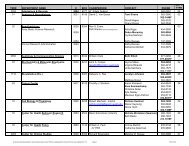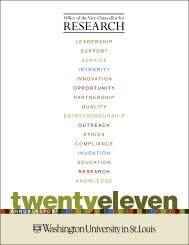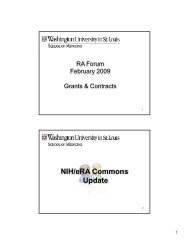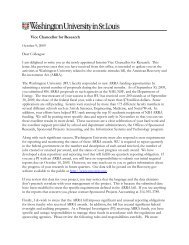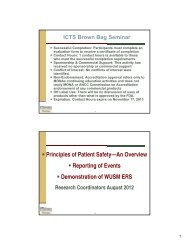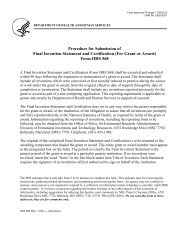Tissue Banking Overview: Washington University Medical Center
Tissue Banking Overview: Washington University Medical Center
Tissue Banking Overview: Washington University Medical Center
Create successful ePaper yourself
Turn your PDF publications into a flip-book with our unique Google optimized e-Paper software.
8/21/2012<br />
Comparison between umbilical cord blood banking and clinical<br />
tissue banking<br />
Issue Comparison Comments<br />
Time dimension of the<br />
biobanking process<br />
Promotion of advantages of<br />
the procedure to physicians<br />
and patients<br />
Link to patient identity<br />
Accreditation<br />
In both fields, specimens are<br />
banked now for an uncertain but<br />
potentially high-impact use in the<br />
future; can be of benefit in ways<br />
not necessarily forseen at the<br />
time of procurement<br />
Communication/education is a<br />
central component of cord blood<br />
banking to increase use of the<br />
procedure; this is also likely true<br />
of clinical tissue banking<br />
Private (though not public) cord<br />
bank specimens linked to patient<br />
identity; required for clinical<br />
tissue banking<br />
Besides FDA regulations, the<br />
American Association of Blood<br />
Banks (AABB), (CAP) and the<br />
Foundation for the Accreditation<br />
of Cellular Therapy (FACT).<br />
Accreditation program for tissue<br />
banks (CAP) released in 2011.<br />
Education of users is required,<br />
since stakeholders often tend to<br />
value only those things that offer<br />
immediate benefits<br />
Helps overcome expectation and<br />
cost barriers, and helps the<br />
practice become more widely<br />
used<br />
Consent process distinct from<br />
that that used for biospecimen<br />
repositories focused on research<br />
Certification standards and<br />
accreditation programs enhance<br />
patient care; they will also<br />
increase patient and physician<br />
confidence in the overall<br />
enterprise, as well as the<br />
individual repositories they use<br />
37



